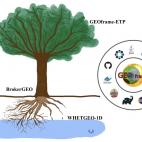Concetta D’Amato, Ph.D. Candidate 35th cycle, University of Trento, DICAM
My research project aims to develop a robust numerical model to estimate the evapotranspiration flow of plants considering the available water present in the soil. The physical phenomena to be considered therefore include three important environmental compartments: soil, vegetation and atmosphere. Water is the common vector to these compartments and the goal is to understand and model how water moves from the soil to the leaves of the plants, through the roots and the stem. LysimeterGEO is the model we have developed, and it simulates the infiltration and the evapotranspiration process considering the type of vegetation and the density of root. As regards the IT implementation, LysimeterGEO is a system of components built upon the Object Modelling System v3 (OMS3).
The infiltration component of the virtual lysimeter is WHETGEO 1D - Water, Heat and Transport in GEOframe (Tubini N. 2021), which simulates water flow, heat and solute transport in variably saturated porous media for the onedimensional case. Evapotranspiration flows are instead estimated using the GEOframe-Prospero model (Bottazzi M. 2020) which estimates the effective transpiration through the equilibrium temperature of the canopy as a function of the stomatal conductance starting from the method of Schymanski and Or (2017). In LysimeterGEO the interaction between infiltration and evapotranspiration is made possible by BrokerGEO component (D’Amato C. 2021), which computes the water stress factor for vegetation by using Jarvis or BallBerry model that I am implementing. BrokerGEO computes the water stress factor considering the water content information by WHETGEO in the soil column discretization and takes in account the depth and density of root for the water removed from soil by evapotranspiration fluxes.
A first applications of the model have highlighted the importance of the root depth in the computation of the real evapotranspiration due to the variation of the water content along the soil profile [D’Amato et al., 2021 in preparation]. However, we are going to implement new models about plants hydraulics, solute transport and travel time within plant. A new version of lysimeter will be implemented for taking in account multiple type of vegetation in the same place. My work is functional to the PRIN 2017 WATZON project

